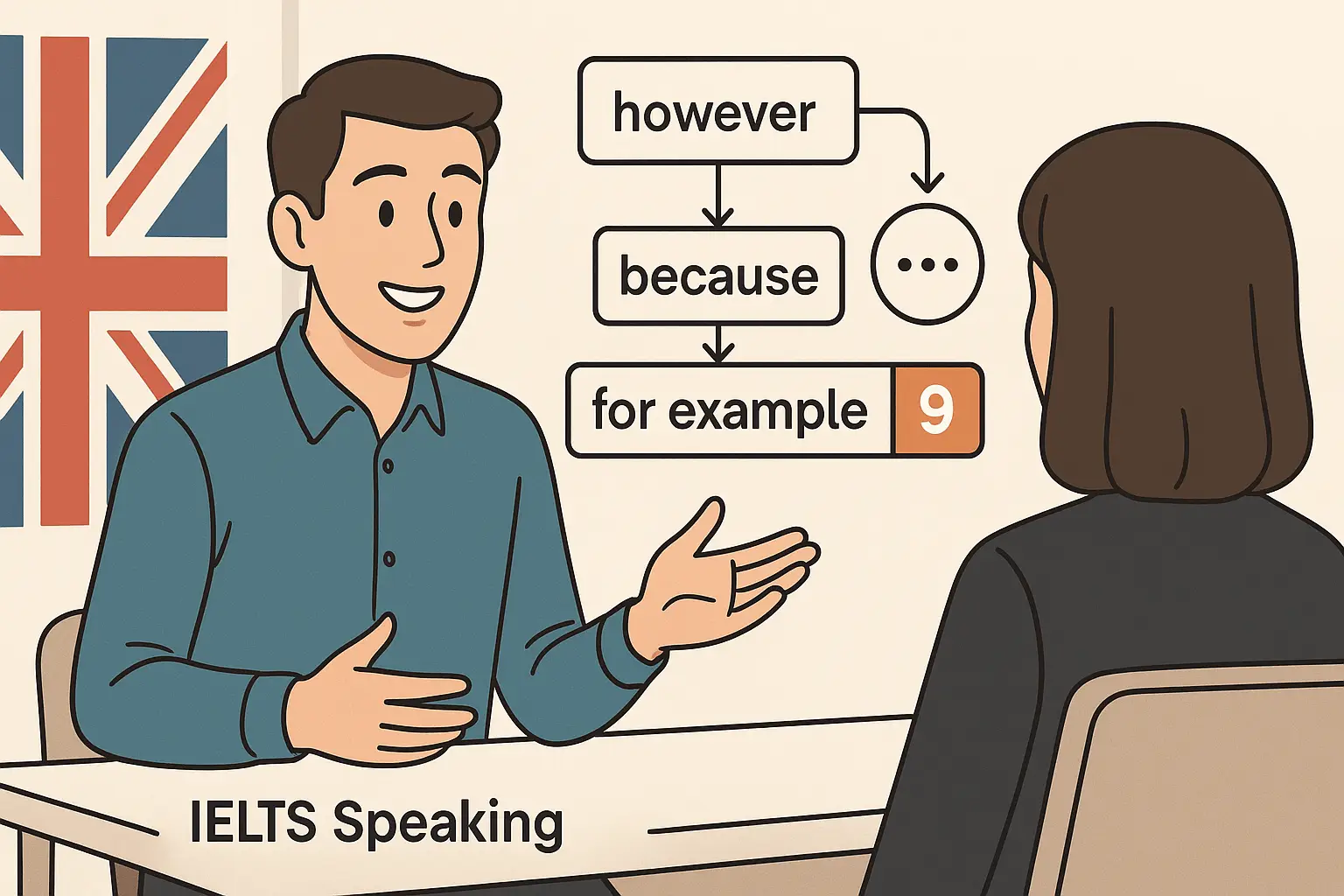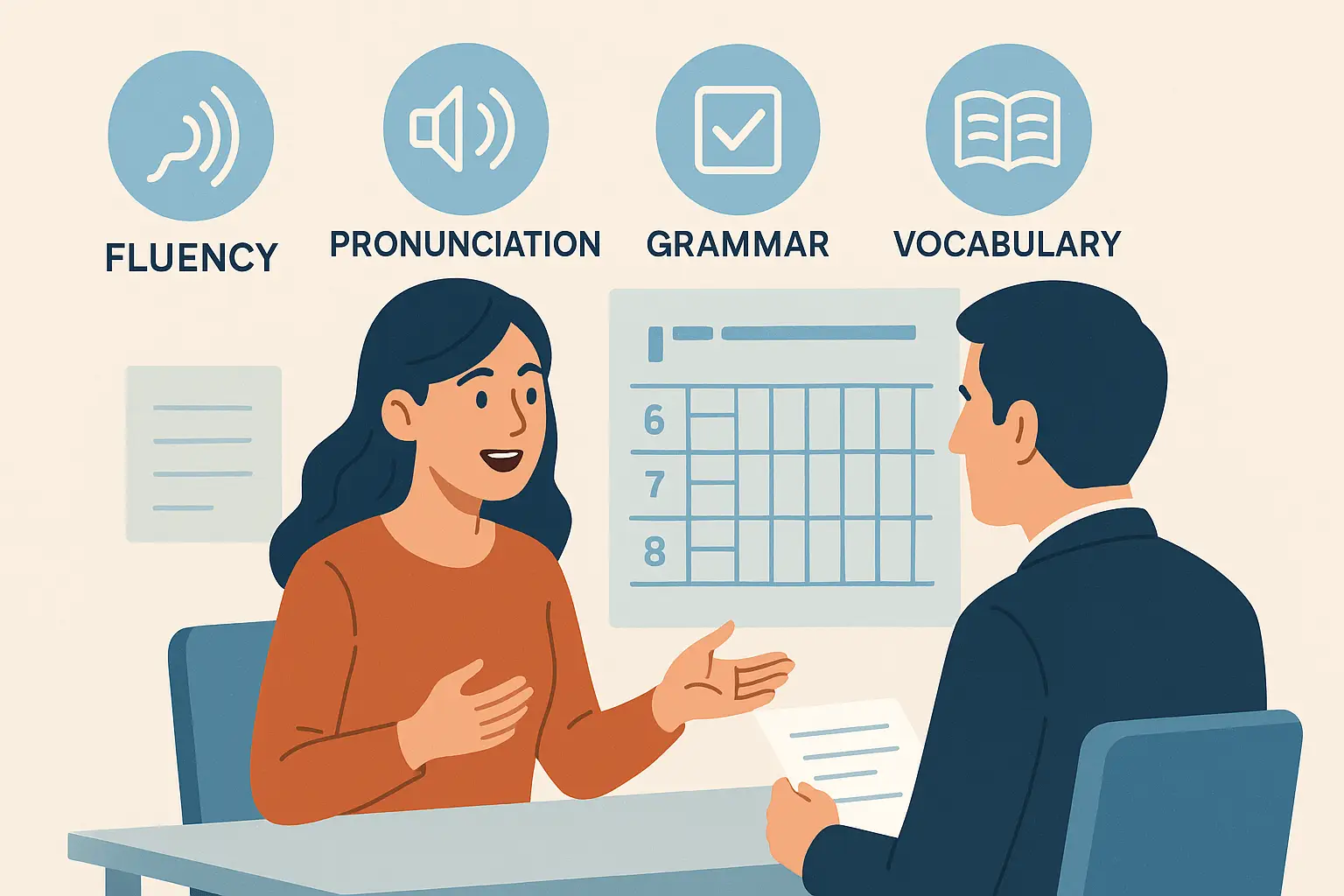- Why Students Struggle With Fluency
- What Are Linking Words and Fillers?
- How Linking Words and Fillers Boost Your IELTS Speaking Score
- Real Student Examples and Corrections
- Useful Linking Words by Function
- Strategic Fillers That Sound Natural
- How I Teach This in My Speaking Lessons
- Final Thoughts
- FAQs – Linking Words and Fillers for IELTS Speaking
As an international IELTS teacher working with learners from over 30 countries, one issue I see time and time again is fluency. Many students know what they want to say but struggle to connect their thoughts smoothly. That’s where linking words and fillers for fluent IELTS Speaking come in. In fact, using these tools strategically can instantly boost both your fluency and coherence—two key criteria in the official IELTS Speaking Band Descriptors.
In this blog, I’ll walk you through the exact techniques I teach my students to sound more natural, structured, and Band 8–9 ready—even when they need a moment to think.
Why Students Struggle With Fluency
When I first started teaching IELTS over a decade ago, I noticed a common pattern. Students with strong vocabulary and grammar still paused awkwardly during the test. The reason? They didn’t know how to link ideas naturally or use fillers appropriately to keep speaking smoothly.
For example, one of my students, Maria from Brazil, had excellent answers but kept saying “uh… hmm… well…” every time she had to think. Once I introduced her to strategic linking words and fillers for fluent IELTS Speaking, she immediately gained confidence and earned a Band 7.5 on her next attempt.
What Are Linking Words and Fillers?
Linking words (also called discourse markers) are words or phrases that show relationships between ideas—like contrast, cause, time, and addition. Examples include:
- However, on the other hand, because, for example, in addition
Fillers, on the other hand, are phrases that buy you time to think without sounding unnatural. These include:
- Well…, Let me think…, That’s an interesting question…, You know…
When used naturally and purposefully, they make your speaking sound fluent—even if you’re mentally planning your next point.
How Linking Words and Fillers Boost Your IELTS Speaking Score
Let’s look at the IELTS Speaking Band Descriptors from IELTS IDP and British Council’s official site. To achieve a Band 7 or higher, you must demonstrate the ability to:
- Speak at length without noticeable hesitation
- Use a range of discourse markers (linking words)
- Maintain fluency even when pausing
Using linking words and fillers for fluent IELTS Speaking helps you tick all three boxes.
Real Student Examples and Corrections
🔹 Before: “I like travelling. Uh… I go with friends. Hmm… it’s good.”
🔹 After: “I like travelling, especially with friends, because we can share experiences together. For example, last year we went to Thailand and had an amazing time.”
Notice how the second version flows effortlessly and sounds confident, even though it communicates the same ideas.
Useful Linking Words by Function
To help you apply this in your own speaking, here’s how I break it down for my students:
Cause and Effect
- Because
- So
- As a result
- Therefore
🗣️ “I usually stay indoors during winter because I don’t enjoy the cold.”
Adding Ideas
- Also
- In addition
- Moreover
- Not only that
🗣️ “I enjoy reading novels. In addition, I listen to audiobooks when I’m commuting.”
Giving Examples
- For example
- Such as
- Like
- In particular
🗣️ “I enjoy outdoor activities, such as hiking and cycling.”
Contrasting or Changing Direction
- However
- On the other hand
- But
- Although
🗣️ “I love city life. However, sometimes it gets too noisy for me.”
Strategic Fillers That Sound Natural
Here are some safe and fluent-sounding fillers that work brilliantly in Part 1, 2, or 3:
- Let me think for a second…
- That’s a good question…
- Well, I guess…
- To be honest…
🧠 Tip from experience: Avoid overusing fillers. Use them only when needed, and always follow with a solid point. For example:
🗣️ “Well, I guess I’d say my favourite season is spring, mainly because everything feels fresh and new.”
How I Teach This in My Speaking Lessons
In my IELTS Speaking Complete Guide, I dedicate entire sessions to building fluency through linking words and fillers. I pair vocabulary banks with speaking drills and personalised feedback.
I also integrate these strategies in my Grammar, Pronunciation & Fluency pillar, ensuring students don’t just memorise words—but use them with control and confidence.
Whether you’re preparing with IELTS.org or booking through British Council, mastering these tools gives you a competitive edge.
Final Thoughts
If there’s one takeaway I can give after years of teaching, it’s this:
“Fluency doesn’t mean speaking fast—it means speaking smoothly.“
And using the right linking words and fillers for fluent IELTS Speaking is one of the simplest yet most powerful ways to improve your fluency today.
FAQs – Linking Words and Fillers for IELTS Speaking
❓What’s the difference between linking words and fillers?
Linking words show the connection between ideas (e.g., however, because), while fillers give you a moment to think (e.g., Well…, Let me see…).
❓Can I use the same linking words in writing and speaking?
Yes—but with caution. Spoken language is usually less formal. For speaking, use words that sound natural, like also, but, so, rather than moreover or therefore.
❓How many linking words should I use in Part 2?
Aim for 4–6 natural linking words or phrases across your full 2-minute answer. Overuse sounds robotic, and underuse causes awkward pauses.
❓Will using fillers lower my score?
Not if used strategically. Saying “Let me think for a second…” is much better than going silent or saying “uhhh…”
❓Where can I practise these effectively?
Check out our IELTS Speaking Complete Guide and fluency pillar at IELTS ZONE—both designed to give you real-time fluency practice.





One Response